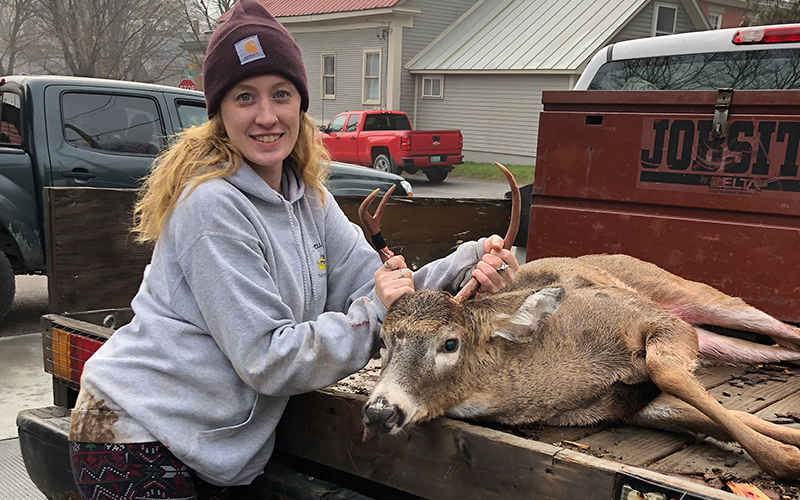Rifle season opened for deer on Saturday, November 13, and things were busy at the state game reporting station at the Village Grocery in Waitsfield as the first hunters showed up with their game.
Don Vasseur, Williamstown, was in with a 135.6-pound buck that he got in Fayston. Alyssa Fillion, Northfield, showed up with her boyfriend and a 137-pound three-pointer that she took in Middlesex.
It was her first deer; she said her boyfriend usually gets the shot. But not on Saturday, she and her boyfriend were hunting in open, tall grass and the deer looked at her, took a turn and she got it with a clean shot to the heart. She said she and her partner regularly hunt deer and was excited that she was the one to get the deer this year.
“We love venison,” she said.
She is the daughter of Fayston road foreman Stuart Hallstrom, who was on hand to congratulate her.
State fish and wildlife biologists Jodi Shippee and Jens Hawkins-Hilke were on hand helping with the weighing and recording of data, but also removing a tooth from each animal taken to definitely determine age. Additionally, he was looking for ticks, winter and wood tick severity “in particular,” he said, with emphasis on the tic syllable.
In addition to teeth and tick checks, Hawkins-Hilke was measuring the antlers, the diameters and the distance between where the points separate from each other.
Shippee said that biologists come to some of the reporting stations, but not all of them, on opening day and also come to record data on youth weekend as well.
A chance visit to the Village Grocery on Sunday found Nick Cosentino with a 138-pound female bear that he said he shot in the woods. The sow had been weighed and was in the back of his truck, allowing for a closer look at an animal most people only see fleetingly. The bear’s fur was longer and courser than might be expected and its claws and feet seemed big in comparison to the body. A yearling bear was harvested at the same time by Cosentino’s hunting companion.
Yearling bears are often harvested with their mothers as part of Vermont’s management of bear population, explained Jaclyn Comeau, Vermont black bear biologist.
“The bear population is extremely robust at this point and harvesting females is the most effective way to control the growth of most wildlife populations,” she said.
Comeau explained that females reproduce every year and a half and the yearling cubs can be harvested with the sows during hunting season. Moreover, it is difficult for hunters to determine the sex of a bear from afar other than to watch a bear for a period of time as it moves around. She said in general male bears are much bigger, but from 200 yards it is not always possible to determine the sex.
“Most females are around 115 to 160 pounds because they put all this energy into producing and raising cubs once they hit maturity. That’s about the same size as a 2- to 4-year-old male,” she said.
Regarding taking yearlings, Comeau said their survival, when not harvested, was tenuous depending on the amount of food available and their ability to den up. Hunters are allowed only one bear tag so when a sow is taken, that same hunter cannot take a yearling but a fellow hunter can.
Over the weekend Hawkins-Hilke reported that they registered 12 deer on Saturday, 11 on Sunday and eight bears over the two days.
Send stories and pictures of deer and bears to













